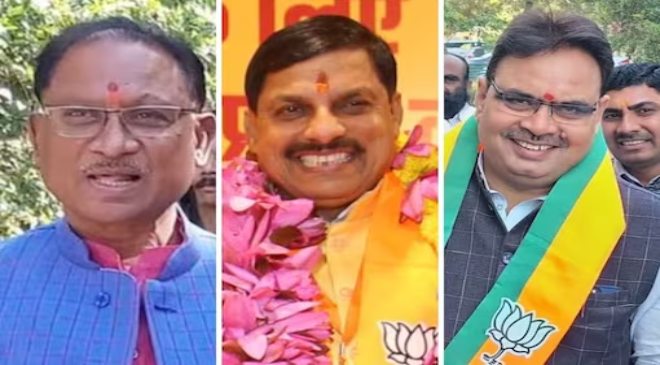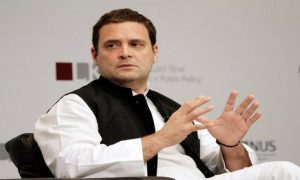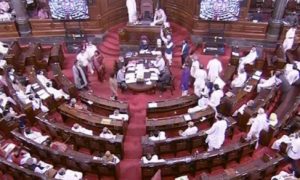By appointing OBC, tribal, and upper caste chief ministers in three states, along with two deputy CMs and one assembly speaker from SC communities, the BJP aims to convey a strong message: it respects every caste. This message is directed both internally to its party workers and externally to voters and other parties advocating for a caste census
The first chapter of the Bharatiya Janata Party’s script for the 2024 Lok Sabha election involves the composition of top leadership in the three Hindi heartland states where it secured emphatic victories this month. These three states collectively hold 65 Lok Sabha and 520 assembly seats. Overall, the Hindi Heartland states – Uttar Pradesh, Bihar, Madhya Pradesh, Rajasthan, Jharkhand, Chhattisgarh, Haryana, Uttarakhand, Himachal Pradesh, and the Union Territory of Delhi – comprise 48% of India’s population, encompassing 225 Lok Sabha and 1,545 assembly constituencies.
Read More: Vishnu Deo Sai Govt in Chhattisgarh to Hold First Cabinet Meet, Discuss Poll Promises
The three new chief ministers picked in Madhya Pradesh, Rajasthan, and Chhattisgarh are not prominent figures. They have been chosen to replace political stalwarts such as Shivraj Singh Chouhan, Vasundhara Raje, and Raman Singh. Their sphere of influence is primarily limited to their respective constituencies. Similar is the scenario of selection of deputy chief ministers. Each state has two deputy CMs, but besides Diya Kumari and Arun Sao, all the others are merely other legislator names in the BJP’s lengthy list of victors.
Their selection follows a clever campaign strategy and election management adopted by the party. It comprises a well-balanced combination of factors such as Prime Minister Narendra Modi’s appeal, a better blend of caste equations, effective communication flow from top to bottom and bottom to top at the constituency level, recognition of the contributions of the party’s grassroots workers, adept social media management, outreach by ministers on union government’s social welfare programs, and intensive canvassing.
Among these factors, cadre-level management stands out as the most critical aspect for any party’s nationwide or state-specific success, whether it is with the Indian National Congress in the past, BJP’s state governments across India now, or its union government in Delhi, Trinamool Congress in West Bengal, DMK or AIADMK in Tamil Nadu, BJD in Odisha, YSRCP in Andhra Pradesh, or other regional parties in India.
BJP’s internal communication within the party appears to be strategically managed, as observed previously, and this recent step further reinforces that notion. Internal communication stands as a fundamental element for organisational excellence, whether in an industrial or non-industrial context. Connected employees foster higher satisfaction levels, leading to improved output. This vertical operation is highly sought after in businesses. The BJP seems to have long adopted this norm within the party, and the message conveyed through the appointment of these chief ministers and deputy chief ministers aligns with this pattern.
Read More: Making Up for Lost Time on ‘Har Ghar Jal’ Deadline Among Bhajan Lal’s Top Priorities as Rajasthan CM
MOTIVATING WORKERS – STIMULUS FOR CADRES
Rajasthan’s chief minister Bhajan Lal Sharma, aged 56, is serving his first term as an MLA. Madhya Pradesh’s CM Mohan Yadav, 58, previously held the position of higher education minister in Shivraj Singh Chouhan’s cabinet. Yadav, perceived as a low-profile OBC leader, has been elected three times as an MLA. Vishnu Deo Sai, a former union minister and a four-term Lok Sabha MP, emerged as a dark horse to surpass other CM contenders in Chhattisgarh. He is 59 years old. All three possess extensive organisational experience with a Sangh background and align with the BJP’s narrative of youthful, anti-dynastic, and grassroots political approaches.
The selection of their names aligns with the messaging thread aimed at common BJP workers, who constitute the backbone behind the party’s victories. While the name of PM Modi serves as the BJP’s flagship, the ground connection relies on the RSS’s Shakha model and the strategy of ‘Panna Pramukh’ that the BJP has adopted. Ordinary BJP workers act as the party’s eyes and ears, reaching out to voters in each assembly and Lok Sabha constituency. Although the model fails as well, at times, as observed in the Karnataka or Himachal Pradesh elections, the party adopts strategies to counter such setbacks. A weak and fragmented opposition only helps.
The Congress was anticipated to secure victories in Rajasthan and Chhattisgarh due to a reported pro-incumbency wave. However, the BJP achieved massive victories even while contesting elections in Prime Minister Narendra Modi’s name against the incumbent CMs of five years. The ground-level connection of the BJP’s election machinery and the diligent efforts of its workers, from MLAs to booth-level cadres, emerged as a major reason for this outcome.
The Congress remained preoccupied with internal conflicts in Rajasthan, and Kamal Nath’s popularity beyond his limited sphere of influence in Madhya Pradesh was insufficient. In Chhattisgarh, Congress chief minister Bhupesh Baghel and deputy chief minister TS Singh Deo were engaged in a five-year power struggle for the top post, with workers largely neglected, many insiders say.
The BJP secured a winning mandate based on Modi’s name, the hard work of party workers, and the distractions within the Congress.
Read More: Surrounded by Teary-eyed Women, Chouhan Turns Emotional, Says He is Not Going Away from MP
THE MODI STORY
A significant part of the BJP’s political messaging, for both internal and external communication, revolves around Narendra Modi’s journey – from an impoverished tea seller to RSS Pracharak to BJP leader to Gujarat’s chief minister and subsequently India’s Prime Minister. The recent selection of chief ministers and deputy chief ministers reinforces this narrative.
All three new CMs come from humble backgrounds. Rajasthan’s CM Bhajan Lal Sharma previously served as BJP’s state general secretary for four terms. The first-term MLA has been an activist in both RSS and ABVP. Similarly, Madhya Pradesh CM Mohan Yadav commenced his political journey within the RSS and ABVP. While Vishnu Deo Sai’s name did arise as a possible CM contender, his political standing in the state did not match that of other contenders such as Raman Singh, Arun Sao, or Renuka Singh.
Similar is the story of the deputy chief ministers. Each state has two deputy CMs. Apart from Diya Kumari and Arun Sao, all of them are ordinary party workers.
The message is clear within the BJP – hard work paves the way for unlimited growth, echoing the journey of Narendra Modi. That’s true even for the Rashtrapati Bhawan. Stories of Ram Nath Kovind, the President of India from 2017 to 2022, and current President of India Droupadi Murmu, work for effective communication outcomes and thus ground connection.
THEORY ON THE GROUND
The support of cadre and ground workers cannot be ignored, particularly when your rival is strong in certain pockets, even if not nationally.
Despite the Congress being humbled, it had a nearly similar vote share in Rajasthan and Chhattisgarh. The BJP secured 41.69% of the votes in Rajasthan, while the Congress’s figure stood at 39.53%. In Chhattisgarh, the BJP received 46.27% of the votes, followed by the Congress with 42.23%. Although there was an 8% gap in Madhya Pradesh, the Congress still garnered 40.40% of the votes. Some months ago in Karnataka, the Congress achieved a spectacular victory, replacing a BJP government. The party also secured impressive victories in Telangana and Himachal Pradesh.
Similar scenarios unfold in other states with various parties where the BJP is emerging as a strong political force, such as Maharashtra, West Bengal, Bihar, Tripura, or Manipur.
The BJP has its governments retained in Uttar Pradesh, Gujarat, Uttarakhand, Haryana, Assam, Goa, Tripura, and Manipur in subsequent polls. It also leads a coalition government in Maharashtra. PM Modi’s name will be a focal point of BJP’s nationwide campaign, and the party has directed its top leaders to reach out to constituencies and engage with ground workers.
The BJP might face a challenging task ahead if the INDIA bloc eventually finalises a seat-sharing plan and contests the 2024 Lok Sabha polls unitedly. The party will require ground workers, who serve as its eyes and ears, to project the Modi brand, achievements of the NDA governments, its promises, and prospects on a winning platform against potential INDIA front’s freebie offers and collective vote shares.
INTERNAL & EXTERNAL COMMUNICATION
A successful communication strategy always comprises a blend of internal and external messages, each reinforcing the other.
The caste survey stands as a major demand of opposition parties in India, including the Congress. The BJP says it doesn’t oppose the idea but suggests that a decision should be made after serious deliberations, emphasising that the matter should not be politicised.
By appointing OBC, tribal, and upper caste chief ministers in three states, along with two deputy CMs and one assembly speaker from SC communities, the BJP aims to convey a strong message: it respects every caste. This message is directed both internally to its party workers and externally to voters and other parties advocating for a caste census. It is going to direct the party’s next campaign in this direction, in each assembly and parliamentary constituency.
Bhajan Lal Sharma hails from the upper castes as a Brahmin, while Vishnu Deo Sai is a tribal leader and Chhattisgarh’s first tribal chief minister. The party has replaced a non-Yadav OBC chief minister with a Yadav OBC in Madhya Pradesh. Yadavs represent a significant portion of the population in the Hindi heartland, constituting 14% in Bihar, 12-14% in Madhya Pradesh, 12% in Haryana, and 9-11% in Uttar Pradesh. In the 2024 Lok Sabha polls, Mohan Yadav is anticipated to be a key campaigner for the BJP, considering that its rivals in Uttar Pradesh and Bihar are two parties dominated by Yadavs: SP and RJD.





































